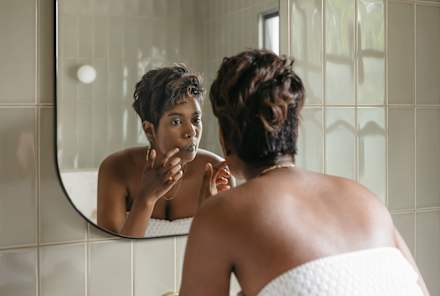Advertisement
Want A Lasting Relationship? Start Doing This, A Couples Therapist Says


Relationships require us to learn new ways of collaborating, communicating, self-reflecting, and of course, growing. If you want to be in a relationship with another person, you have to expand. If you want to be in a conscious relationship, you need to centralize the relationship. Centralizing the relationship often means decentralizing yourself, which can be challenging.
In a sense, relationships are meant to be challenging because we have to expand who we are to be with another person. Being in a relationship with another person will bring up our stuff, and when our stuff gets triggered, rather than just reacting to it, we have the opportunity to build the capacity to tolerate really uncomfortable feelings.
For optimal growth and healing, each person in a relationship has to develop aspects of themselves that are underdeveloped—and heal parts of themselves that have been wounded.
Our relationships need a heavy dose of tolerance
Being in a conscious, mutually satisfying relationship means that both people must periodically surrender what they think is "right" in order to expand and incorporate another person and their perspective. While these growth pains may be uncomfortable, we evolve as a result of this process, and in the end, experience a deeper connection.
A recent study conducted by the University of Georgia and the University of California, Los Angeles, found that experiencing an increase in the number of problems isn't actually what determines the end of a relationship. In fact, what they discovered is that the issue was low tolerance for the same old issues.
These findings are consistent with the Gottmans' research, which shows that over 60% of marital problems are perpetual and "unsolvable," and what separates the relationship masters from the relationship disasters are couples who can tolerate each other's differences.
What tolerance really is — and isn't
Tolerance doesn't mean "putting up" with your partner's behavior. Tolerance means expanding your capacity to be with the parts of your partner, or the parts of your experience, that bring you discomfort.
Conscious couples build capacity for each other's differences. They develop an embodied tolerance for ambiguity, which allows them to be with two things at one time. Conscious couples are able to approach unsolvable issues with regulation, playfulness, acceptance, and humor.
Unconscious couples do not learn to accept their partner's differences. When unconscious couples encounter unsolvable issues, they find themselves in gridlocks of control, conflict, dominance, coercion, giving up, and resentment.
These strategies end up creating a lack of safety and emotional distance within the relationship.
Note: In some contexts, there are good reasons for a lack of tolerance. If you feel unsafe, or if you and your partner have opposite stances on values such as parenting, finances, or relationship agreements, it may be unsafe, unhealthy, or indicate too much incompatibility.
Factors that erode tolerance:
A lack of differentiation resulting from early development
"Differentiation" is an active, ongoing process of defining self, revealing self, clarifying boundaries, and managing the anxiety that arises out of either being too close or too far away in a relationship. Lack of differentiation plays a large part in lowering a person's capacity for differences.
Unrealistic expectations that "happy couples" don't have issues and are in a state of romantic bliss
Having unconscious idealizations about what a relationship is "supposed to be" lowers a person's tolerance and takes them out of the reality of being in (and working on) the relationship they have.
How to build more tolerance in your relationship
Get curious about the ways in which you reject, attack, or object to your partner's differences. What part of you gets triggered? How do you behave when you get triggered?
Practice structured Imago Dialogue (covered in my course!), which supports couples to build the capacity for being with each other's differences without interruption, shame, blame, or criticism.
Ask yourself: What is the deeper meaning behind my lack of tolerance? Usually, there is a narrative ("the story I tell myself") that reveals something that has a lot more to do with you than it does with your partner.
Build capacity to stay regulated and present when you are experiencing your partner's differences. If you notice yourself getting triggered, how can you quiet yourself down and ground yourself so that you can stay curious about your partner's differences instead of attacking them?
For years my husband would leave his shoes by the door. I would ask him over and over again to open the closet and put the shoes in the closet.
When he didn't, I would get angry and tell myself stories about his disregard for me, my inability to reach him, and his lack of care. We fought about the shoes for years, and then one day I decided to stop.
Now, I let his shoes stay where they are in the hallway. Sometimes, I put them in the closet like a little meditation, saying, "I love these little feet." If I can have a shoeless hallway or my marriage, I'd rather have my marriage.
Understanding your triggers
A few years ago, I coined the phrase "invisible investments," or the idea that seemingly small issues in partnership (like a relational effort going unnoticed) can actually have much deeper roots.
Some years ago, I had taken the time to find a podcast I thought could help my husband with a situation at work. A while later, when I asked him if he'd listened yet and he said, "No," I felt a flash of heat move through my stomach, which I noticed as frustration.
Instead of saying something critical or dismissive, I took a brief pause, invited myself to slow down a bit, and explained to him why I was feeling hurt. He looked at me kindly and said, "I didn't know that. Thanks for telling me."
When we experience an intense reactive physiological response (i.e., when we get "triggered"), it alerts us to a historical pattern in our nervous system. Rather than avoiding these feelings, we can embrace them as invitations to follow the roots of this response into our pasts, so we can explore the history, meaning, and unconscious responses that are driving our present-day reactions.
One of the central causes of conflict in a relationship is when our conception about how our partner should behave in the relationship conflicts with the reality of who our partner is. This can sound like:
- If you loved me, you'd take action more quickly…
- If you loved me, you'd ask me about my day more…
- If you loved me, you'd initiate sex more…
- If you loved me, you'd text me more…
- If you loved me, you wouldn't require so much of me…
We create these conditions in our mind for love and then hold our partner to these expectations, often without ever having made them explicit. And if, and when, we do make these expectations explicit, we bypass our curiosity about how they relate to this area of our connection.
So often, when our relational needs aren't being met and we don't feel seen and valued, we leave the us stance and enter into a you versus me stance—wherein we make ourselves the victim of our partner's differences.
If my partner moves slowly, I can either see all the ways they do this in the world and observe this quality as a reality about who they are, or I can observe their slowness only in relation to me and focus on all the areas I'd like them to speed up. This is how we make ourselves victims to our partner's way of being in the world.
We have to interrogate the conditions we impose that only serve to alienate us from our partner. And if we aren't skillful about how we express our needs, these conditions can make our partner feel inadequate, criticized, or defensive.
We have to ask ourselves:
- What is so intolerable about (insert frustrating quality)?
- What does that say about who they are?
- What does that say about the world?
- What does that say about me?
- And most importantly… Can I observe this quality about who they are instead of seeing it as something being done to me?
This self-inquiry isn't about lowering the bar or sacrificing your needs. Your ability to reflect on how your partner's way of being becomes a threat to you is the path toward building tolerance.
Your ability to notice the meaning you assign to your partner's behavior allows you to have more choice about how you respond.
In the end, you can choose to adjust your expectations or not, but that decision has to come from the whole of you, not just the triggered part of you.
The takeaway
The more tolerant you become, the more you can feel embodied presence, and the more presence you enjoy, the more the world opens up to you as colorful, safe, and adventurous.
Every time you notice how you can position yourself differently to make more room for your partner's differences, it makes a bigger container for both of you.
You are the artist of your life, and if you endeavor to walk the path of consciousness, you actually have a lot of choice about the architecture of your relationship house.
If you hyperfocus on the few ways you're not getting what you want and you also cast yourself as a victim of the reality of who your partner is, the interior of your home will always be lacking.
If you focus on what you do have and the ways your partner does show up, you will be surrounded by abundance—which is a beautiful feeling to come home to.











